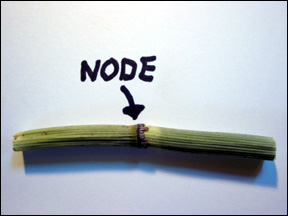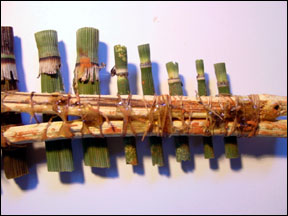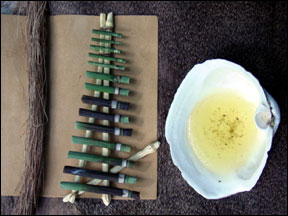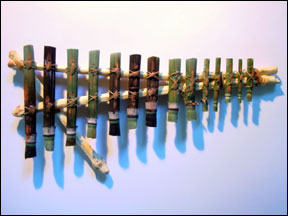
Strolling by a patch of horsetail (Equisetum hyemale), it is hard to resist cutting a length of this slender, abrasive plant and blowing across an open end for its sharp whistle effect. Upon witnessing a friend play his pan flute one day, I realized that I could fashion one out of horsetail.

This horsetail pan flute is easy to make, but takes patience and dexterity, especially when securing each piece of horsetail to the frame. I initially made the mistake of using fresh horsetail when assembling my first pan flute. This resulted in whistles that shrank away from the frame and the yucca bindings, as well as buckled into unattractive, tone-less hanks of horsetail. It seems very important to thoroughly and slowly dry whole horsetail stems in a cool place devoid of direct sunlight. For the material in my locale, this process took three weeks.

The next step is to cut the horsetail into suitable lengths to produce whistles of different pitches. I find that using a swift chopping motion with an antler cleaver works well, giving a clean cut without crushing the horsetail. When cutting horsetail into whistles, you don't want pieces that are totally hollow. One must leave an intact node, or cross-wall, inside the length of each piece. Some species of Equisetum branch at these nodes. I have not had success making whistles out of these species. Experiment, experiment, experiment! Knowing nothing about music, I cut a couple hundred pieces and blew away, setting aside those that "sounded right." Generally, the longer and/or wider the piece, the lower it will sound. Coincidentally (I whimsically prefer instinctively), when I finished selecting those whistles I deemed good enough to affix to a frame, a musician friend informed me that my arrangement decently coincided with a nearly two octave scale, starting with a C (438 Hz).

For the triangular frame, I chose clematis, which was light and handy. Here was the most difficult part of this endeavor - attaching the horsetail to the frame, which proved to be intricate and taxing to my dexterous capabilities. In the photos you can see the grand fir pitch and yucca fibers I used to attach the whistles to the frame. After I tied the frame together with yucca, I glued each whistle to the frame using the heated pitch. Upon drying, I then tied the horsetail to the frame with a yucca fiber, with the thicker fibers being more reliable (but be careful not to crush the horsetail when cinching down your knots!). Occasionally a whistle would dislodge from the frame with handling, so re-application of pitch was necessary. When each whistle was finally tied to the frame, I re-enforced the bindings with a drop of heated pitch. On the finished product, I rubbed ochre rock dust on all pitched surfaces to eliminate stickiness.

This is a great activity to do with kids: it gives them a real
connection with their environment; utilizes a widespread resource
(here in the Pacific Northwest); and produces a final product
that their parents don't mind them having (as opposed to, say,
a stone blade). Enjoy!
Visit Storm's website at www.stoneageskills.com.
Storm (1969 - 2008)
Storm immersed himself into the wellspring of adventure and the experience of the Stone Age. Thank you, Storm, for sharing your heartfelt enthusiasm of the wilderness and skills of the past through your engaging articles. You will be sorely missed.
We hope the information on the PrimitiveWays website is both instructional and enjoyable. Understand that no warranty or guarantee is included. We expect adults to act responsibly and children to be supervised by a responsible adult. If you use the information on this site to create your own projects or if you try techniques described on PrimitiveWays, behave in accordance with applicable laws, and think about the sustainability of natural resources. Using tools or techniques described on PrimitiveWays can be dangerous with exposure to heavy, sharp or pointed objects, fire, stone tools and hazards present in outdoor settings. Without proper care and caution, or if done incorrectly, there is a risk of property damage, personal injury or even death. So, be advised: Anyone using any information provided on the PrimitiveWays website assumes responsibility for using proper care and caution to protect property, the life, health and safety of himself or herself and all others. He or she expressly assumes all risk of harm or damage to all persons or property proximately caused by the use of this information.
© PrimitiveWays 2013